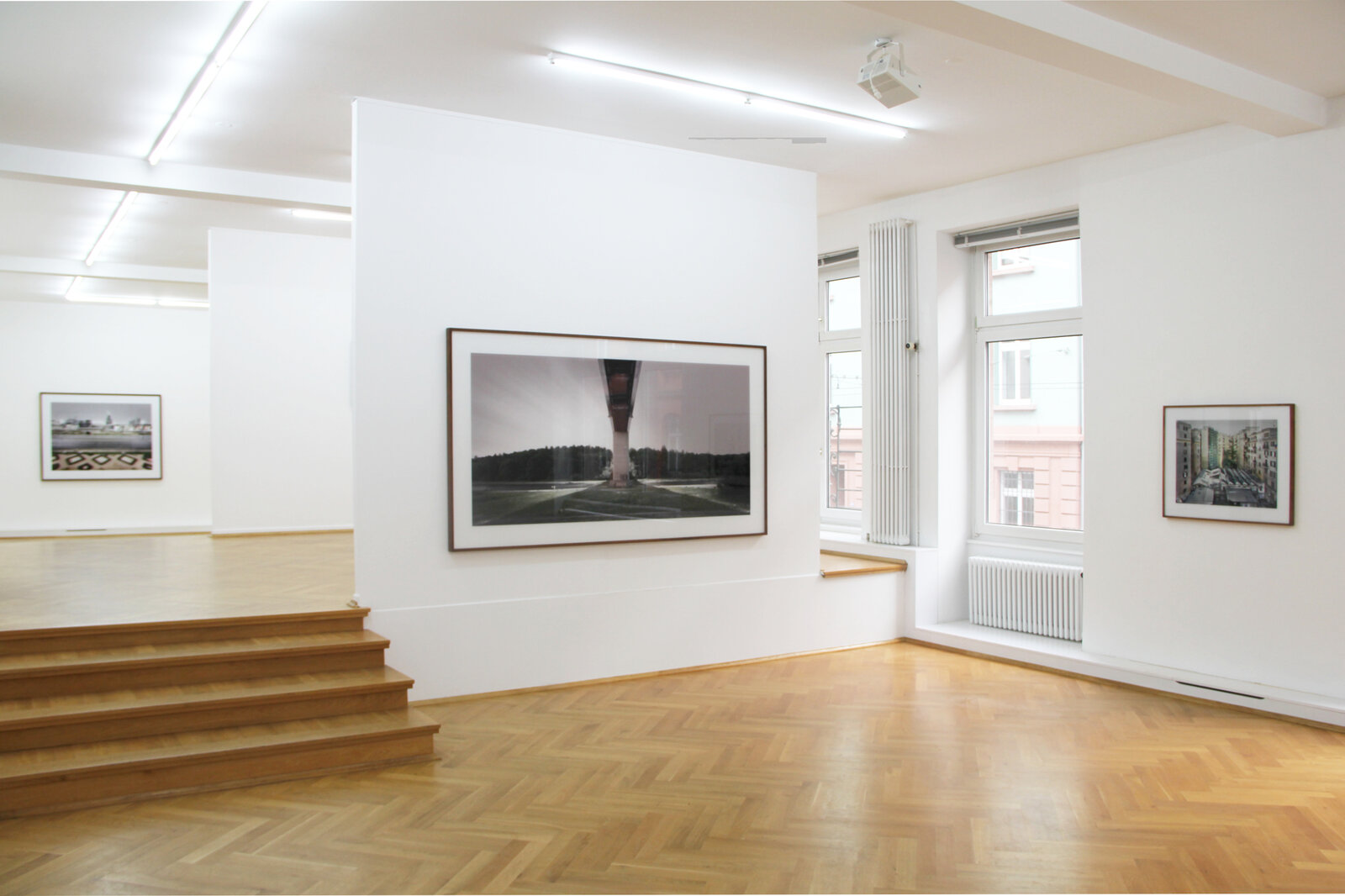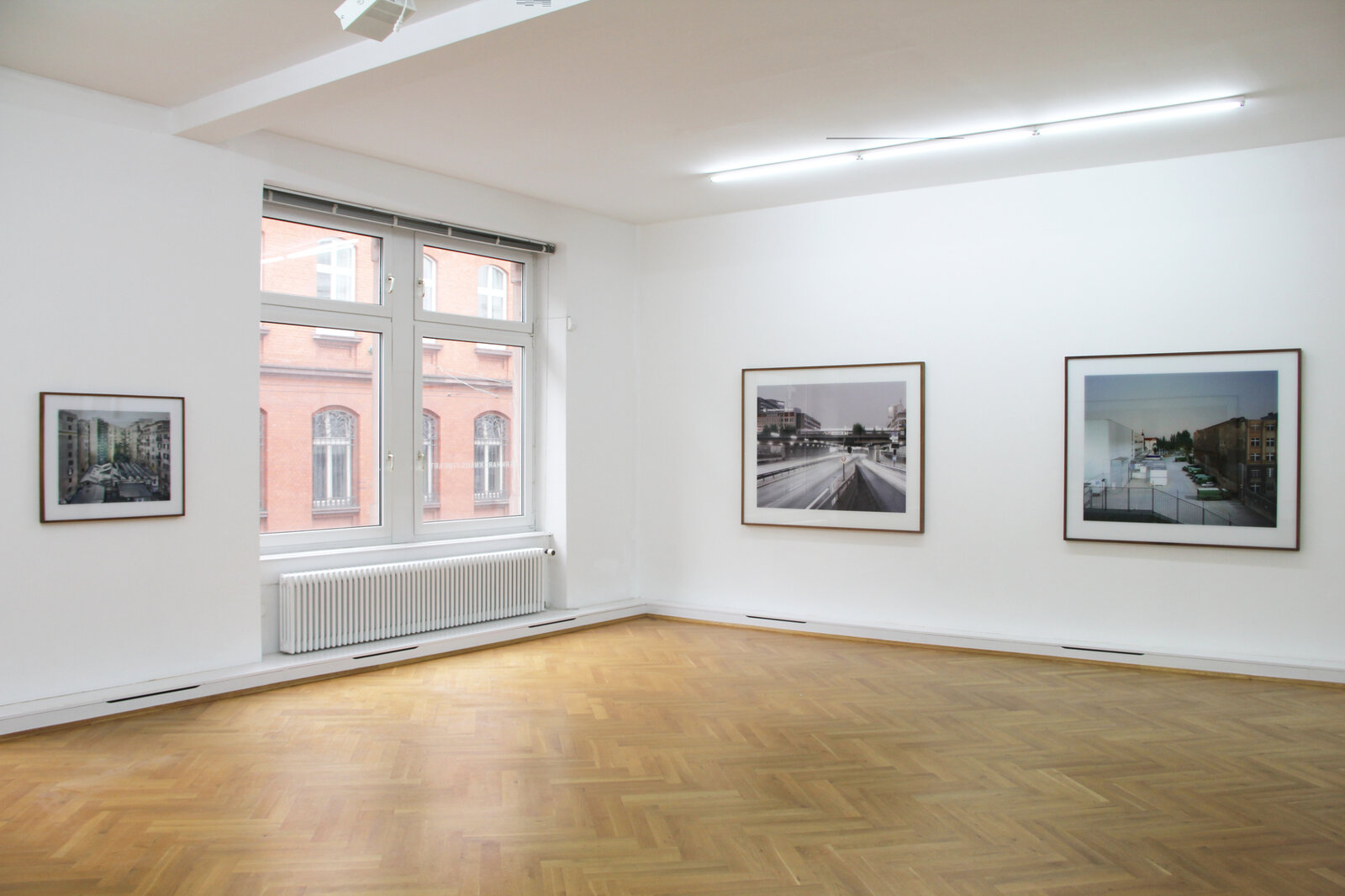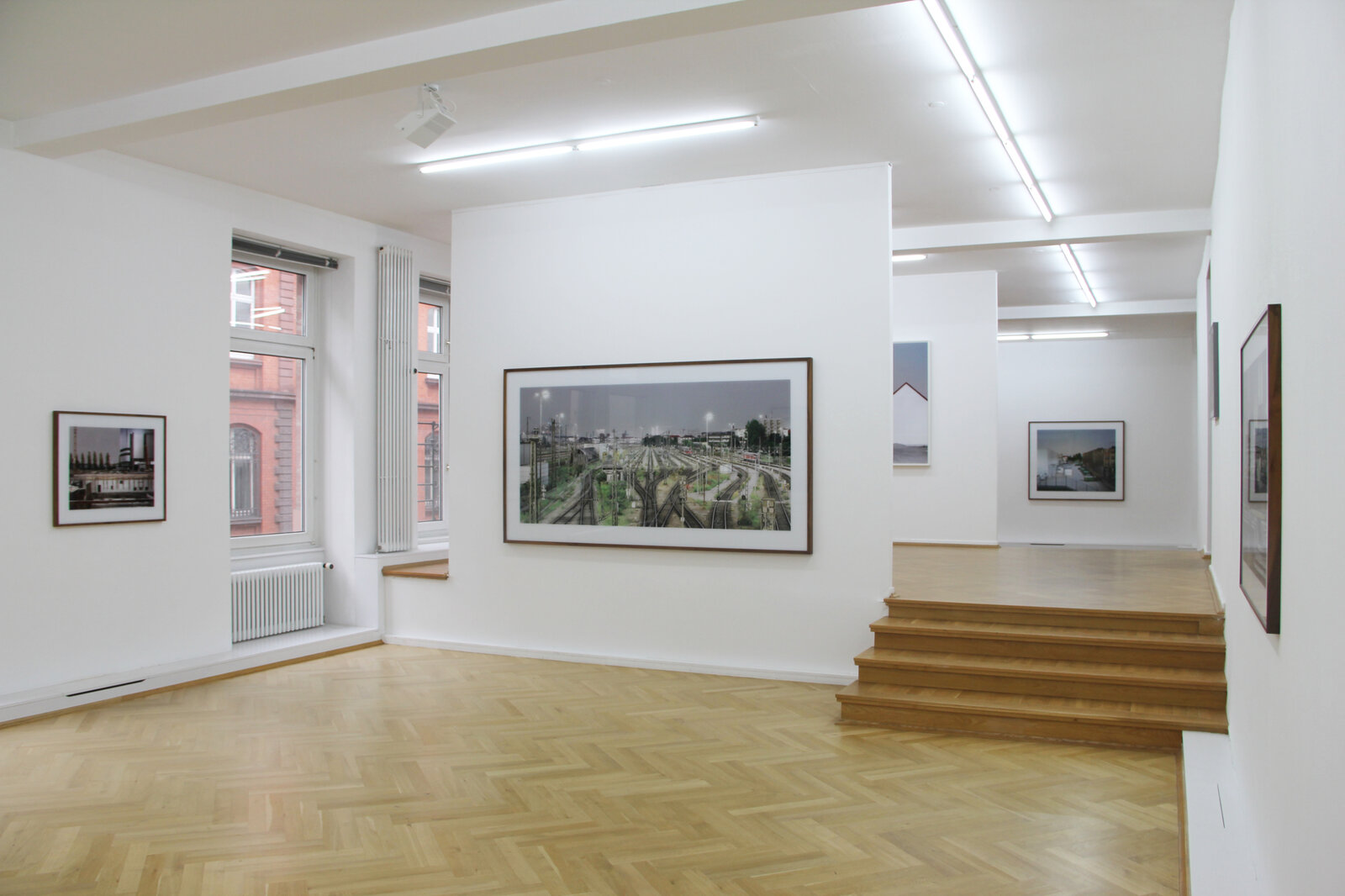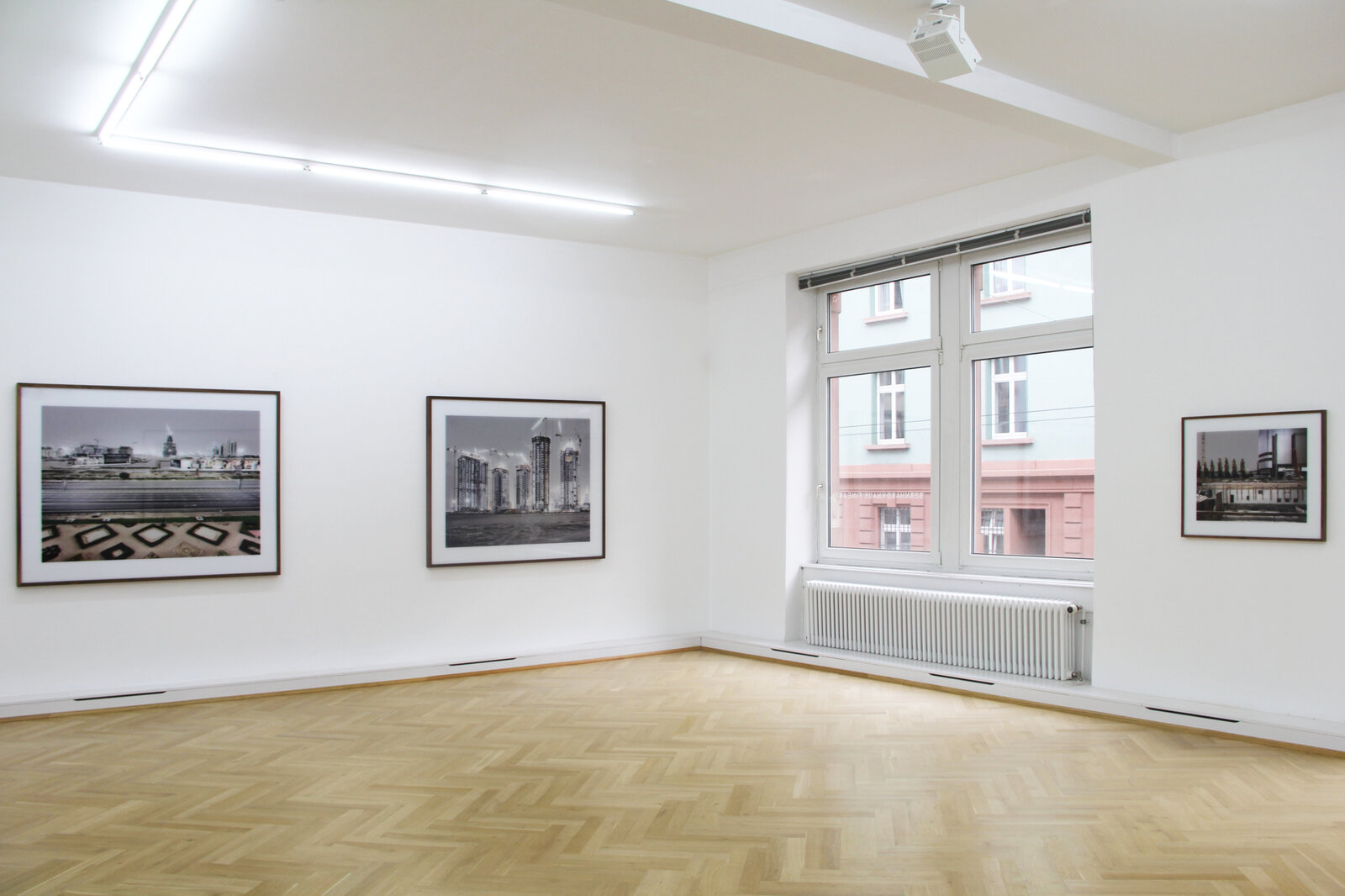01.11. - 08.12.2012
From November 1 to December 8, 2012, Bernhard Knaus Fine Art is showing photographic works by the Munich artist Thomas Weinberger (born 1964) in a first solo exhibition.
Thomas Weinberger's large-format works are reminiscent of unusual moments, such as those presented to us before thunderstorms and their rapidly changing lighting conditions; or moments shortly before dusk, when the last rays of the sun hit flat facades and create unreal, dreamlike situations. However, the viewer quickly realizes that these cannot be real situations found by the photographer: This mood, evoked primarily by the light and which predominates in Weinberger's photographs, was created artificially.
With a classic large format camera, the artist takes at least two identical views of the motif at different times of the day or night. The images are then digitized and their values are offset against each other on the computer to form a single image. The analog recording only serves as "raw material from which I work out the final shape of the light" (Thomas Weinberger). The images, which are always taken from the same point of view, are combined through this procedure to create a synthetic visual experience in which the light conditions of day and night are mixed together in one image. The clearly defined point in time of each individual recording is paradoxically dissolved by this compression. "With its perfectionist, all-encompassing approach, this approach represents an exaggeration of the essence of photography, which ultimately leads it ad absurdum with regard to its claim to depict reality and thereby liberates it from it."
The possibility of digital processing has not only significantly changed the understanding of photography, it has also freed it from many restrictions and dogmas, such as those formulated by "straight photography", for example. Light and time were previously indispensable constituents of the photographic image and were stylized accordingly as the essence of the medium. Today, however, they can be manipulated beyond time and aperture settings as well as exposure when developing the print. Photography has thus become a medium that can emphatically exhibit its artificiality. Weinberger therefore also comments on the history of the medium by exaggerating the light.
Thomas Weinberger prefers to choose anonymous urban spaces or industrial areas for his photographs, whereby he is interested in the transitions between these spaces and nature. Set pieces from "nature" can be found in all of the photographs, be they geometrically laid out flower beds, a trimmed lawn, overgrown bushes or isolated trees. The artist is fascinated by strange, indefinite and eerie places. He shows us places devoid of people, but which are clearly designed and shaped by people. His choice of motif is not serial, but situational: In order to be able to take several pictures of exactly the same shot, the industrial plants or streets must be illuminated at night. The lighting suggests that the places are particularly important. But in view of these non-places, which are primarily of economic and practical importance, the lighting becomes transparent as a means of control. Nevertheless, Weinberger's pictures in their charged tension convey a poetry beyond this factual reality.
Since the first exhibition in 2005, Thomas Weinberger has become internationally known within a very short time. His work has already been shown at the Palais des Beaux Arts in Brussels (2007), the Australian Center for Photography in Sydney (2007), the Center Culturel Calouste Gulbenkian in Paris (2008) and the Center Pompidou, Paris (2010). His work is represented in numerous international private and public collections.
Thomas Weinberger's large-format works are reminiscent of unusual moments, such as those presented to us before thunderstorms and their rapidly changing lighting conditions; or moments shortly before dusk, when the last rays of the sun hit flat facades and create unreal, dreamlike situations. However, the viewer quickly realizes that these cannot be real situations found by the photographer: This mood, evoked primarily by the light and which predominates in Weinberger's photographs, was created artificially.
With a classic large format camera, the artist takes at least two identical views of the motif at different times of the day or night. The images are then digitized and their values are offset against each other on the computer to form a single image. The analog recording only serves as "raw material from which I work out the final shape of the light" (Thomas Weinberger). The images, which are always taken from the same point of view, are combined through this procedure to create a synthetic visual experience in which the light conditions of day and night are mixed together in one image. The clearly defined point in time of each individual recording is paradoxically dissolved by this compression. "With its perfectionist, all-encompassing approach, this approach represents an exaggeration of the essence of photography, which ultimately leads it ad absurdum with regard to its claim to depict reality and thereby liberates it from it."
The possibility of digital processing has not only significantly changed the understanding of photography, it has also freed it from many restrictions and dogmas, such as those formulated by "straight photography", for example. Light and time were previously indispensable constituents of the photographic image and were stylized accordingly as the essence of the medium. Today, however, they can be manipulated beyond time and aperture settings as well as exposure when developing the print. Photography has thus become a medium that can emphatically exhibit its artificiality. Weinberger therefore also comments on the history of the medium by exaggerating the light.
Thomas Weinberger prefers to choose anonymous urban spaces or industrial areas for his photographs, whereby he is interested in the transitions between these spaces and nature. Set pieces from "nature" can be found in all of the photographs, be they geometrically laid out flower beds, a trimmed lawn, overgrown bushes or isolated trees. The artist is fascinated by strange, indefinite and eerie places. He shows us places devoid of people, but which are clearly designed and shaped by people. His choice of motif is not serial, but situational: In order to be able to take several pictures of exactly the same shot, the industrial plants or streets must be illuminated at night. The lighting suggests that the places are particularly important. But in view of these non-places, which are primarily of economic and practical importance, the lighting becomes transparent as a means of control. Nevertheless, Weinberger's pictures in their charged tension convey a poetry beyond this factual reality.
Since the first exhibition in 2005, Thomas Weinberger has become internationally known within a very short time. His work has already been shown at the Palais des Beaux Arts in Brussels (2007), the Australian Center for Photography in Sydney (2007), the Center Culturel Calouste Gulbenkian in Paris (2008) and the Center Pompidou, Paris (2010). His work is represented in numerous international private and public collections.







